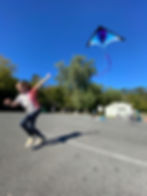Wind & Kites
- morgan743
- Nov 7, 2020
- 3 min read

Who has seen the wind?
Neither I nor you,
But when then leaves hang trembling
The wind is passing through.
Who has seen the wind?
Neither you nor I,
But when the trees let down their boughs
The wind is passing by.
Lake and Park children recite this poem by Christina Rosetti year after year as they watch wind take leaves from trees each fall. Many come to know the poem by heart.
This September, we began our school year with a study of wind and kites; a perfect theme of focus as we learned to transition learning from indoors to outdoors and maintain physical distance from one another in light of the COVID-19 pandemic.
Each day children watched for the wind. Younger children learned to feel the direction the wind blew. Older children sought to uncover the origins of wind and why some days are calm while others blustery. Everyone learned to see evidence of the wind's presence in swaying branches, passing clouds, drifting seagulls and ripples across the lake.
"You know the wind is there when your hair blows all around." -India
Once children tuned their attention to the wind's presence, it felt natural to begin playing with it. What happens when a scarf is tossed into the windy sky? Will wind help a paper airplane fly? Do you need wind to fly a kite?



Children arrived at school with a variety of their own colorful kites to fly through the many open green spaces nearby school. As children shared their kites, we noticed the unique shapes, colors and symmetry of each one. Some simple, diamond shaped designs, others complicated octopuses and unicorns.


Children took equal joy in flying their kites and and cheering when kites lifted into the air. They shared many observations as they watched:
"They dive and swoop"
"They dance and flutter"
"They twirl"
"They are like soaring, majestic birds"
"The are sleek and silent"
As we looked at kites in books, artwork and photos, children recreated kites in all forms and sizes from a multitude of colorful materials.


After learning about children in Cambodia using discarded plastic bags and sticks to construct kites, Big Room children attempted to design and build their own kites from plastic shopping bags. The classroom itself became a mess, with bits of plastic blowing through open windows and doors. The benefit of being immersed in materials is it often leads to impulsive sparks of innovation and a continuous desire to try something new.


The dynamics of kite flying depend on a complex series of factors, among them the shape and construction of the models, the materials used, wind conditions and the ability of the kite flyer.
As model after model emerged, children learned how the subtle differences in shape and size affected the flight of a kite; how the length of the tail affected balance; how the angle of the triangular keel affected lift; how symmetry creates stability.
Some days wind joined us and everyone's kites swirled and danced with little effort from the flyer - sometimes as high as thirty feet. Other days, the air was still and we learned to create our own wind by running.


After each flight, children reflected on what could be modified to make their kite fly higher, faster or straighter. Often, they made adjustments at the park: lengthening the bridle, repairing a spar, adding additional tails. This process of testing and modifying became a rhythm we returned to each day. Part of the magic of kite-making is that there doesn't seem to be an end to this rhythm. There's always another idea; a new design to try.


Kite making is engineering as much as a form of art. In watching kite makers share their design process, children grew inspired to make their own designs, extending from the basic delta shape.
The joy of watching and feeling one's kite lift high into the sky kept us returning to kite flying each afternoon. The unpredictability of the wind and the unique dance of each kite leaves much to be discovered. This same excitement and awe is felt around the world, as kite flying is such an accessible activity for many. With materials easily collected and the only real necessity being wind, just about everyone participates.

As our study neared its end, we decided to hold an all-school kite festival to celebrate all we learned. Children were inspired by the annual kite festivals that take place in various corners of the world. We learned that some of these festivals date back 500 years.


Everyone attended the festival. Children flew their kites all afternoon and watched some lift almost 100 feet into the air. It was a blustery day! Some children also learned to make their own delta kites out of simple materials: wooden dowels, plastic bags and tape.

The festival day came to an end before we were ready. We look forward to bringing the kites to the meadow again one day.

